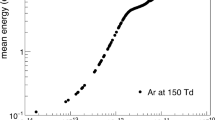Abstract
In the present paper an evaporation model is implemented and assessed in a Computational Fluid Dynamics (CFD) code named ISIS. First, the influence of the cell size and time step on the temperature field is studied via simulations with a prescribed fuel Mass Loss Rate (MLR). Then, the evaporation model is assessed using predictive simulations. The experimental scenario is a 30 cm-diameter heptane pool fire. The average fuel Mass Loss Rate Per Unit Area (MLRPUA) is predicted within 5.5% deviation from the experimental value. In addition, an analysis of the temperature and heat fluxes at the surface of the liquid, the mass transfer coefficient and the temperature inside the liquid is performed.







Similar content being viewed by others
Notes
The CFD code ISIS can be freely downloaded from the following website: https://gforge.irsn.fr/gf/project/isis/.
References
Audouin, L., Rigollet, L., Prétrel, H., Le Saux, W., Rwekamp, M.F.: OECD PRISME project: Fires in confined and ventilated nuclear-type multi-compartments-Overview and main experimental results. Combust. Sci. Technol. 176, 945–958 (2004)
Prétrel, H., Suard, S., Audouin, L.: Experimental and numerical study of low frequency oscillatory behaviour of a large-scale hydrocarbon pool fire in a mechanically ventilated compartment. Fire Saf. J. 63, 125–143 (2016)
Beji, T., Merci, B.: Blind Simulation of periodic pressure and burning rate instabilities in the event of a pool fire in a confined and mechanically ventilated compartment. Combust. Sci. Technol. 188, 504–515 (2016)
Novozhilov, V., Koseki, H.: CFD Prediction of pool fire burning rates and flame feedback. Combust. Sci. Technol. 176, 1283–1307 (2004)
Hostikka, S., McGrattan, K.B., Hamins, A.: Numerical modeling of pool fires using LES and the finite volume method for radiation. Fire Saf. J. 7, 383–394 (2003)
Sikanen, T., Hostikka, S.: Modeling and simulation of liquid pool fires with in-depth radiation absorption and heat transfer. Fire Saf. J. 80, 95–109 (2016)
Babrauskas, V.: Estimating large pool fire burning rates. Fire Technol. 19, 251–261 (1983)
Klassen, M., Gore, J.P.: Structure and radiation properties of pool fires NIST-GCR-94-651 (1994)
Hamins, S.J., Fisher Kashiwagi, T., Klassen, M., Gore, J.P.: Heat feedback to the fuel surface in pool fires. Combust. Sci. Technol. 97, 37–62 (1994)
Prasad, K., Li, C., Kailasanath, K., Ndubizu, C., Ananth, R., Tatem, P.A.: Numerical modelling of methanol liquid pool fires. Combust. Theor. Model. 3, 743–768 (1999)
Jacobs, A.F.G., Welgraven, D.: A simple model to calculate the Sherwood and Nusselt numbers for discs of various shapes. Int. J. Heat Mass Transf. 31, 119–227 (1988)
Llorens, M., Miranda, L.A.: Ingeniería térmica, p. 153, Marcombo (2009)
Nicoud, F., Ducros, F.: Subgrid scale stress modelling based on the square of the velocity gradient tensor. Flow Turbul. Combust. 176, 1283–1307 (2001)
Ruiz, J., Kaiser, A.S., Zamora, B., Cutillas, C.G., Lucas, M.: CFD analysis of drift eliminators using RANS and LES turbulent models. Appl. Therm. Eng. 105, 979–987 (2016)
Sadiki, A., Agrebi, M., Chrigui, A.S., Doost, R., Knappstein, F., Di Mare, J., Janicka, A., Massmeyer, D., Zabrodiec, D., Hess, R., Kneer, R.: Analyzing the effects of turbulence and multiphase treatments on oxy-coal combustion process predictions using LES and RANS. Chem. Eng. Sci. 166, 283–302 (2017)
Hurley, M.J., Gottuk, D.T., Hall, J.R. Jr, Harada, K., Kuligowski, E.D., Puchovsky, M., Torero, J.L., Watts, J.M. Jr, Wieczorek, C.J.: SFPE handbook of fire protection engineering, p 311. Springer, Quincy (2002)
Magnussen, B.F., Hjertager, B.: On mathematical modeling of turbulent combustion with special emphasis on soot formation and combustion. Sixteenth symposium (International) on Combustion 16, 719–729 (1977)
Sikanen, T., Hostikka, S.: Numerical simulations of liquid spreading and fires following an aircraft impact. Nucl. Eng. Des. 318, 147–162 (2017)
Kassem, I.H., Khalid, M.S., Hossam, S.A., Mohsin, M.S., Mazlan, A.: Implementation of the eddy dissipation model of turbulent non-premixed combustion in openFOAM. Int. Commun. Heat Mass Transfer 38, 363–367 (2011)
McGrattan, K.B., Hostikka, S., Floyd, J.E., Baum, H.R., Rehm, R.G., Mell, E., McDermott, R.: FDS technical reference guide. vol. 1: Mathematical model, FDS Version 5.4. NIST, p. 63 (2009)
Minkowycz, W.J., Sparrow, E.M.: Advances in numerical heat transfer, pp. 109–119. Taylor and Francis, New York (2002)
Chai, J.C., Hsu, P.-f., Lam, Y.C.: Three-dimensional transient radiative transfer modeling using the finite-volume method. J. Quant. Spectrosc. Radiat. Transf. 86, 299–313 (2004)
Coelho, P.J.: Advances in the discrete ordinates and finite volume methods for the solution of radiative heat transfer problems in participating media. J. Quant. Spectrosc. Radiat. Transf. 145, 121–146 (2014)
Novozhilov, V.: Computational fluid dynamics modelling of compartment fires. Prog. Energy Combust. Sci. 27, 611–666 (2001)
Maragkos, G., Beji, T., Merci, B: Advances in modelling in CFD simulations of turbulent gaseous pool fires. Combust. Flame 181, 22–38 (2017)
Acknowledgements
Jose Felipe Perez Segovia is a PhD student funded by Bel V. The authors are grateful for the technical support provided by S. Suard, L. Audouin, H. Prétrel, G. Boyer, M. Mense, and F. Babik from IRSN.
Funding
This study was funded by Bel V.
Author information
Authors and Affiliations
Corresponding author
Ethics declarations
Conflict of interests
The authors declare that they have no conflict of interest.
Additional information
Publisher’s Note
Springer Nature remains neutral with regard to jurisdictional claims in published maps and institutional affiliations.
Rights and permissions
About this article
Cite this article
Perez Segovia, J.F., Beji, T. & Merci, B. Assessment of an Evaporation Model in CFD Simulations of a Free Liquid Pool Fire Using the Mass Transfer Number Approach. Flow Turbulence Combust 101, 1059–1072 (2018). https://doi.org/10.1007/s10494-018-9943-1
Received:
Accepted:
Published:
Issue Date:
DOI: https://doi.org/10.1007/s10494-018-9943-1




